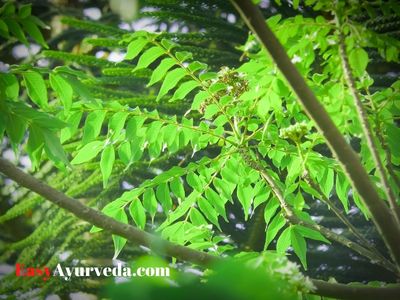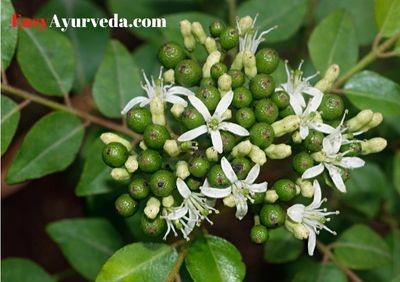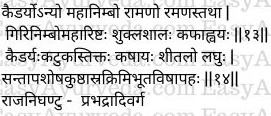Curry Leaves (Kadi Patta) Qualities, Remedies, Research
By Dr Renita D’Souza
Curry leaves (Kadi Patta – Murraya koenigii) are well known for adding exotic flavors to Indian cuisine. It has medicinal properties and used to treat various diseases since ancient times. It is used in fever, diarrhea, dysentery, vomiting, anemia, skin pigmentation etc. Curry leaves are best hair tonic, blood purifier and ideal natural calcium supplement.
Table of Contents
Dietetics
As per Ayurveda, last section of the meals should contain pungent, bitter and astringent ingredients. It is a challenge to find bitter and astringent ingredients that gel well with other dishes. Curry leaf (Kadi Patta) is a perfect ingredient which goes well with buttermilk, curd, rice and can be even made part of Sabji or vegetable salad. It can be eaten raw or cooked.
Introduction

Botanical Name – Murraya koenigii
Synonyms – Murraya paniculata (Linn.)
Family – Rutaceae
Vernacular Names
English Name – Curry leaf
Sanskrit Name – Surabhinimba
Hindi Name – Mitha Neem, Kurry Patta, Kadi patta, Kathnim
Assam Name – Narasingha
Bengali Name – Barsanga, Kartaphulli
Gujrati Name – Gorenimb
Marathi Name – Kadhilimb
Kannada Name – Karibevu
Orissa Name – Bhursanga
Telugu Name – Karepaku
Malayalam Name – Kattu kari veppu, Maramulla, Paanama, Kariveppilei
Tamil Name – Karuveppilei, Karivempu, Kattuveppilei.
Dutch Name – Kerriebladeren
French Name – Feuilles de cury
German Name – Curryblatter
Indonesian Name – Daun kari
Italian Name – Fogli de Cari
Spanish Name – Hoja.
Botanical Description
Murraya koenigii is a small shrub growing upto 2-2.5 meter tall. Stem is dark green and brown in color. Leaves are pinnate, bearing 12 – 24 leaflets and have reticulate venation. Flowers are white, funnel-shaped arranged in panicles and have sweet aromatic smell. Fruits are round to oblong in shape, 1.4-1.6 cm in length, green in color and turn black when fully ripe. Each fruit contain one seed which is 11 mm long, 8 mm in diameter and spinach green in color.

Kadi patta Medicinal Qualities
Taste (Rasa) – Astringent, Bitter and Sweet taste
Vipaka (Taste after digestion) – Katu (Pungent)
Guna (Qualities) – Laghu (light to digest), Snigdha (Unctous)
Virya (Potency) – Shita (Cold)
Action (Karma) -Ruchya (improves taste), Deepana (Kindles digestive fire), Pachana (Improves digestion), Vishagna (Antitoxic), Varnya (improves complexion)
Effect on Doshas
Kaphapittahara – Balances Kapha and Pitta dosha
Part Used
Leaves, Bark, Stem, Fruits and Roots
Curry leaves Remedies
- In diarrhea, green leaves of Murraya koenigii are eaten raw.
- In morning sickness curry leaves are used along with lime juice.
- Murraya koenigii leaves paste used to treat boils.
- Root juice of Curry leaf is used to relieve renal pain.
- Roots and bark of curry leaf is used to treat poisonous animal bite.
- Curry leaves infusion is used to treat vomiting.
- Curry leaf paste with buttermilk is taken for empty stomach is beneficial in stomach upsets.
- Fresh Curry leaf juice can be used to prevent development of cataract.
Sanskrit Verses

Pharmacological Activities
Murraya koenigii possess antioxidant, antimicrobial, anthelmintic, analgesic, anti-inflammatory, antidiarrheal, hepatoprotective, nephroprotective, antitumor, hypoglycemic, hypolipidemic and immune modulatory properties.
Nutritional Values
Murraya koenigii leaves contain proteins, minerals, carotene, carbohydrate, fibre, vitamin C, vitamin A, nicotinic acid, calcium and oxalic acid.
Distribution
Murraya koenigii is found native to India, Sri Lanka, Bangladesh and Andaman Islands.
Chemical Constituents
Murraya koenigii contains carbazole alkaloids, essential oil, terpenoids, flavonoids, carbohydrates, phenolics, nicotinic acid, carotene, furocoumarins and vitamin C.
Research
Antioxidant and Antimutagenic Activity – A research study done to evaluate antioxidant and antimutagenic activities of Murraya koenigii leaves have proved that phenolic-rich benzene fraction has promising broad-spectrum antioxidant and antimutagenic property.
Antidiabetic Activity – A study done on Anti-Diabetic potential of Murraya koenigii (L.) and its Antioxidant capacity in Nicotinamide-Streptozotocin induced diabetic rats have proved that Murraya koenigii possesses significant antidiabetic activity and antioxidant activity.
Formulations
Kaidaryaadi kashaayam – Ayurvedic decoction used for the treatment of amoebic dysentery, indigestion and sprue syndrome.
Kalasakadi kashayam – It is herbal decoction used in constipation, fever and low digestion
Ulciherb capsule – Ayurvedic medicine used in Hyperacidity.
Scientific Classification
Kingdom – Plantae
Subkingdom – Tracheobionta
Superdivision – Spermatophyta
Division – Magnoliophyta
Class – Magnoliopsida
Subclass – Rosidae
Family – Rutaceae
Genus – Murraya J. Koenig
Species – Murraya koenigii
Sanskrit Synonyms
Mahanimba, Raamano, Ramana
Girinimba
Maharishta
Shuklashaala
Click to Consult Dr Renita D’Souza










2 comments
Khalid Hamza Lakdawala
Is Curry leaf good for hair health?
Dr J V Hebbar MD(Ayu)Author
Yes, very useful.